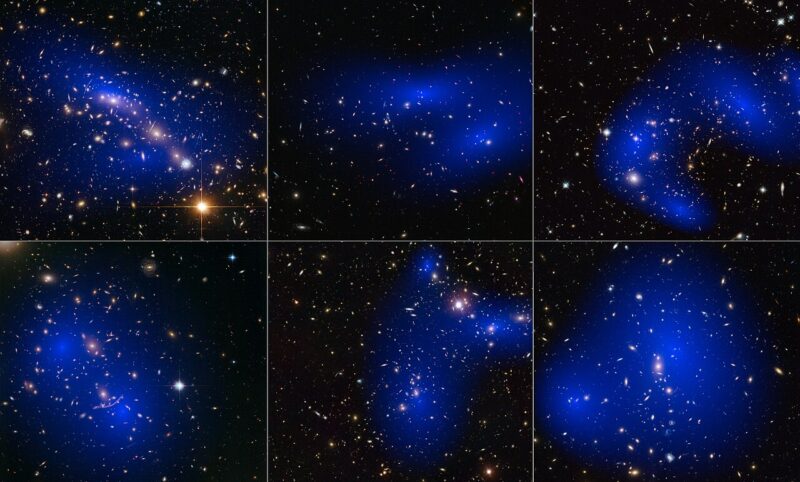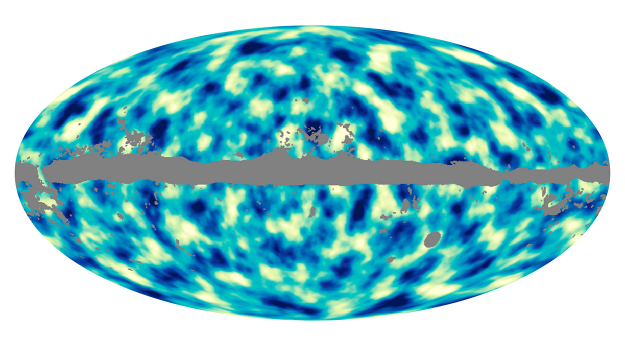
What is dark matter?
Dark matter is a mysterious substance thought to compose perhaps about 27% of the makeup of the universe. What is it? It’s a bit easier to say what it isn’t.
It isn’t ordinary atoms, the building blocks of our own bodies and all we see around us. Atoms make up only somewhere around 5% of the universe, according to a cosmological model called the Lambda Cold Dark Matter Model (aka the Lambda-CDM model, or sometimes just the Standard Model).
Dark matter isn’t the same thing as dark energy. Dark energy makes up some 68% of the universe, according to the Standard Model.
Dark matter is invisible; it doesn’t emit, reflect or absorb light or any type of electromagnetic radiation such as X-rays or radio waves. Thus, instruments can’t detect dark matter directly, as all of our observations of the universe, besides detecting gravitational waves, involve capturing electromagnetic radiation in our telescopes.
How does it interact with ordinary matter?
Yet dark matter does interact with ordinary matter. It exhibits measurable gravitational effects on large structures in the universe such as galaxies and galaxy clusters. Because of this, astronomers can make maps of the distribution of dark matter in the universe, even though they cannot see it directly.
They do this by measuring the effect dark matter has on ordinary matter, through gravity.

WIMPs and supersymmetry
Currently, a huge international effort to identify the nature of dark matter is underway. Astronomers are bringing an armory of advanced technology to bear on the problem. They’ve designed ever more complex and sensitive detectors to tease out the identity of this mysterious substance.
Dark matter might consist of an as yet unidentified subatomic particle. It would be completely different from what scientists call baryonic matter. That’s just ordinary matter, the stuff we see all around us. Ordinary atoms built of protons and neutrons make up baryonic matter.
The list of candidate subatomic particles includes Weakly Interacting Massive Particles (WIMPs). This class of particles arose in the early universe, it is thought. Astronomers believe that WIMPs might self-annihilate when colliding with each other, so they have searched the skies for telltale traces of events such as the release of neutrinos or gamma rays.
So far, they’ve found nothing. In addition, although a theory called supersymmetry predicts the existence of particles with the same properties as WIMPs, repeated searches to find the particles directly have also found nothing. Experiments at the Large Hadron Collider to detect the expected presence of supersymmetry have completely failed to find it.
WIMP detectors
Researchers have used several different types of detectors to detect WIMPs. The general idea is that very occasionally, a WIMP might collide with an ordinary atom and release a faint flash of light. The most sensitive detector built to date is XENON1T, which consists of a 10-meter (about 30-foot) cylinder containing 3.2 tons of liquid xenon. Photomultipliers surrounding it detect and amplify the incredibly faint flashes from these rare interactions. In July 2019, a more sensitive instrument, the XENONnT, took the place of XENON1T, which had detected no collisions between WIMPs and the xenon atoms.
Although WIMPs have long been the favored candidate for dark matter, they’re not the only candidates. The failure to find WIMPs, and the attendant frustration with not being able to account for a significant percentage of the universe’s mass, has led many scientists to look at possible alternatives.
At the moment, a hypothetical particle called the axion stands out as important. As well as being a strong candidate for dark matter, the existence of axions may provide answers to a few other persistent questions in physics such as the Strong CP Problem.

Dark matter history
The idea that there might be things in the universe which are invisible to us, that emit no light, has a long history going back hundreds of years to the days of Newton. With the discovery of so-called “dark nebulae” – clouds of interstellar dust blocking the light from background stars – and Pierre Laplace’s 18th-century speculations about objects which might swallow light, later to become known as black holes, astronomers came to accept the existence of a so-called “dark universe.”
But in modern times, astronomer Fritz Zwicky, in the 1930s, made the first observations of what we now call dark matter. His 1933 observations of the Coma Cluster of galaxies seemed to indicate that it has a mass 500 times more than that previously calculated by Edwin Hubble. Furthermore, this extra mass seemed to be completely invisible. Although Zwicky’s observations initially met much skepticism, other groups of astronomers later confirmed them.
Vera Rubin and dark matter
Thirty years later, astronomer Vera Rubin provided a huge piece of evidence for the existence of dark matter. She discovered that the centers of galaxies rotate at the same speed as their extremities. They should rotate faster. Think of a vinyl LP on a record deck: its center rotates faster than its edge. That’s what logic dictates we should see in galaxies too. But we do not. The only way to explain this is if the whole galaxy is only the center of some much larger structure. Imagine it as only the label on the LP, causing the galaxy to have a consistent rotation speed from center to edge.
Vera Rubin, following Zwicky, postulated that the missing structure in galaxies is dark matter. Her ideas met much resistance from the astronomical community, but her confirmed observations now create pivotal proof of the existence of dark matter. In honor of this crucial and historic piece of detective work toward establishing the existence of dark matter, the revolutionary Large Synoptic Survey Telescope recently received the name Vera C. Rubin Observatory.

Is dark matter necessary?
Some astronomers have tried to negate the need the existence of dark matter altogether. They postulate something called Modified Newtonian dynamics (MOND). The idea behind this is that gravity behaves differently over long distances from what it does locally. This difference of behavior would explain phenomena such as galaxy rotation curves which we attribute to dark matter.
MOND has its supporters and it can account for the rotation curve of an individual galaxy. But current versions of MOND simply cannot account for the behavior and movement of matter in large structures such as galaxy clusters. In its present form it cannot completely account for the existence of dark matter. That is to say, gravity does behave in the same way at all scales of distance. Most versions of MOND, on the other hand, have two versions of gravity, the weaker one occurring in regions of low mass concentration such as in the outskirts of galaxies. However, it is not inconceivable that some new version of MOND in the future might yet account for dark matter.
Some astronomers believe we will establish the nature of dark matter in the near future. But the search so far has proved fruitless. We know that the universe often springs surprises on us so that nothing can be taken for granted.
The approach astronomers are taking is to eliminate those particles which cannot be dark matter, in the hope we will be left with the one which is.
Is this approach the correct one? Time will tell.
Read more:
What Is Supersymmetry? from How Stuff Works
Miraculous WIMPs, from Symmetry Magazine
Modified Newtonian dynamics, from Physics World
Vera Rubin and Dark Matter, from the American Museum of Natural History
Bottom line: Dark matter makes up some 27% of the universe according to astronomical theories. The existing tools of astronomers can’t see or detect it. However, its gravitational pull on ordinary matter enables astronomers to measure it.











